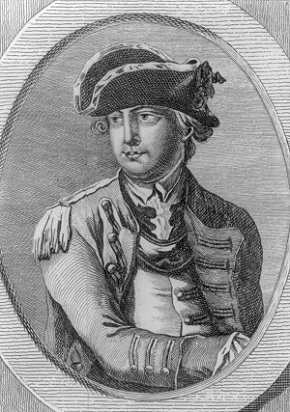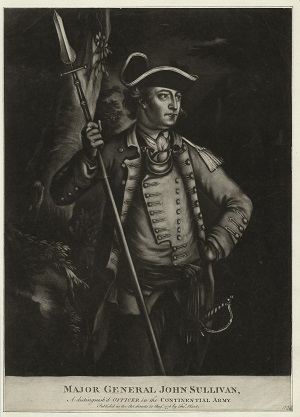Who Served Here?
John Armstrong: Page 2
A decade and a half after serving the British against the French, Armstrong was called upon to render military service again, this time opposing the same crown he once served. On March 1, 1776, Congress elected John Armstrong Brigadier-General. A resolution was passed:
"That General Armstrong was directed to repair to South Carolina, there respectively to take command of the forces until they receive further orders from Congress or a superior officer."
General Armstrong arrived in Charleston in April, 1776, bolstering its defenses against an expected British siege, which arrived on June of 1776, in the Battle of Sullivan's Island, in which the Americans repulsed the British onslaught. By this time, Major-General Charles Lee had arrived to take over command. Armstrong was given charge over the troops at Haddrell's Point, an important position in safeguarding Charleston.
In January of 1777, Washington and his army were encamped at Morristown, New Jersey. Washington suspected that the British would most likely make their move against the capital: Philadelphia. During that summer, Washington kept his troops between Philadelphia and New York, ready for a possible strike against the city. In a letter of July 4, 1777, Washington writes Armstrong:
I am yet perplexed to find out the real intention of the enemy but upon a presumption that their views are up the North River. I have advanced General Sullivan's division as far as Pompton and the main body of the army to this place. In this position I shall lie till I receive more certain information of their design. I have dismissed all the militia of this State, except about one hundred who serve as a guard for the stores at Pompton and Succasony Plains; and it would be very agreeable to me to have as few as possible of those of Pennsylvania kept in service, because their time at this season of harvest, it truly valuable to them
Armstrong had recently been promoted to Major-General within the Pennsylvania state militia. Washington noted the promotion in the same letter:
"I am pleased at the honorable mark of distinction, which the State of Pennsylvania has conferred upon you by appointment to the command of its State troops, and am convinced that by your acceptance of it you will be enabled to render the State and your country very essential service, should she herself be attacked, or her assistance demanded by any of her sister States."
Armstrong played a key role in the Battle of Brandywine. Under the command of General John Sullivan, Washington had forces in position north of Chadds Ford. Armstrong commanded troops at Pyle's Ford, about ten miles south of Chadds Ford. His militia was respoinsible for guarding a large cache of military supllies. The Americans were poorly equipped, but fought hard all day long. In the evening they withdrew and marched to Chester. Armstrong protected the American stores and under his direction, they were removed from the area.
Washington's army was at Pottsgrove (Pottstown, Pennsylvania) and soon marched to Pennebecker's mills (Schwenksville, Pennsylvania) where they established camp. Washington then called a council of war on September 28, including General Armstrong as a member. The men mainly discussed the feasibility of an attack at Philadelphia.
By October 2, the army was marching along the Skippack road to Worcester township. Captured enemy documents informed the Americans that Howe had divided his forces into two sections to capture the two forts at Philadelphia. One large British force was located at Germantown and Washington decided to attack there. Each general had specific orders:
General Armstrong to pass down the Ridge road at the Sandy Run — thence to White Marsh Church — there take the left hand road which leads to Jenkins' Tavern on the old York road, then keep down the old York road below Armitage's beyond the seven mile stone; half a mile from which a road turns off short to the right fenc'd on both sides, which leads through enemy's encampment at Germantown Market House.
General MacDougall to attack the right wing of the enemy in flank — General Smallwood and Foreman to attack their right wing in flank and Genrl Armstrong to strike their left wing in flank and rear.
— From Weedon's Orderly Book
The foggy day and the impregnable Chew House (Cliveden) helped bring the battle to an end. Washington wrote Congress on the 5th of October:
"The morning was extremely foggy which prevented our improving the advantages we gained, so well as should otherwise have been done. Upon the whole, it may be said the day was rather unfortunate than injurious. The enemy are nothing better by the event and our troops who are not in the least dispirited, have gained, what all young troops gain by being in action."
After Germantown, Armstrong secured permission to withdraw from his command due to precarious health and returned to Carlisle. Washington and the Continental Army, of course, spent the winter of 77-78 at Valley forge. Early in the spring of 1778, Armstrong wrote to Washington concerning the possibility of returning to the army. Washington replied that he would welcome Armstrong's service, but Armstrong was instead elected to Congress in 1778 and served to 1780. And again from 1787-1788.
Armstrong was a strong supporter of Washington and advocated his election as President of the United States. In the closing years of his life, General Armstrong was consulted frequently about affairs of Pennsylvania. He died in Carlisle, on March 9, 1795.
Bibliography:
Abridged from the article by Charles William Heathcote, Ph.D., The Picket Post, Valley Forge Historical Society; November 1959





